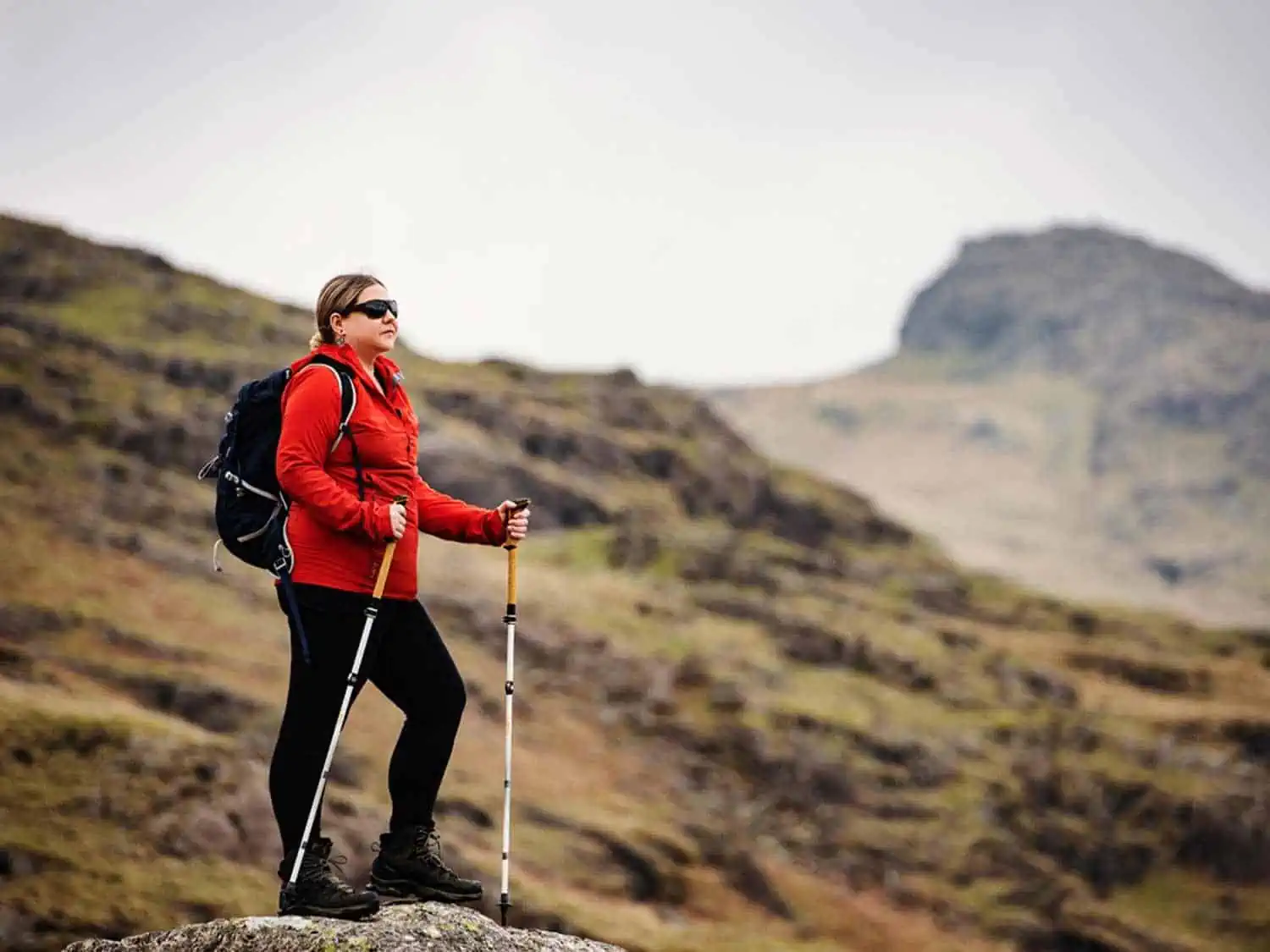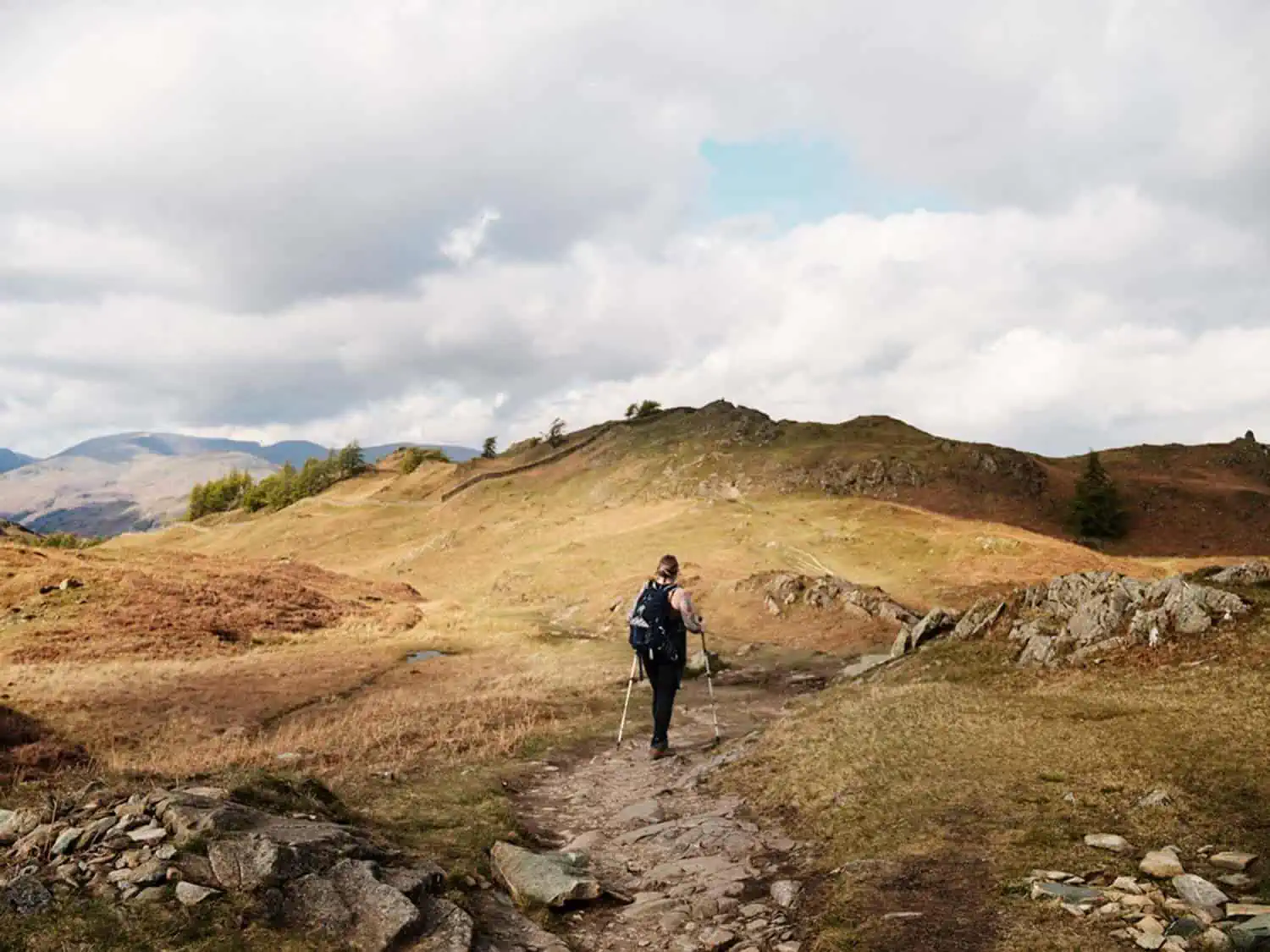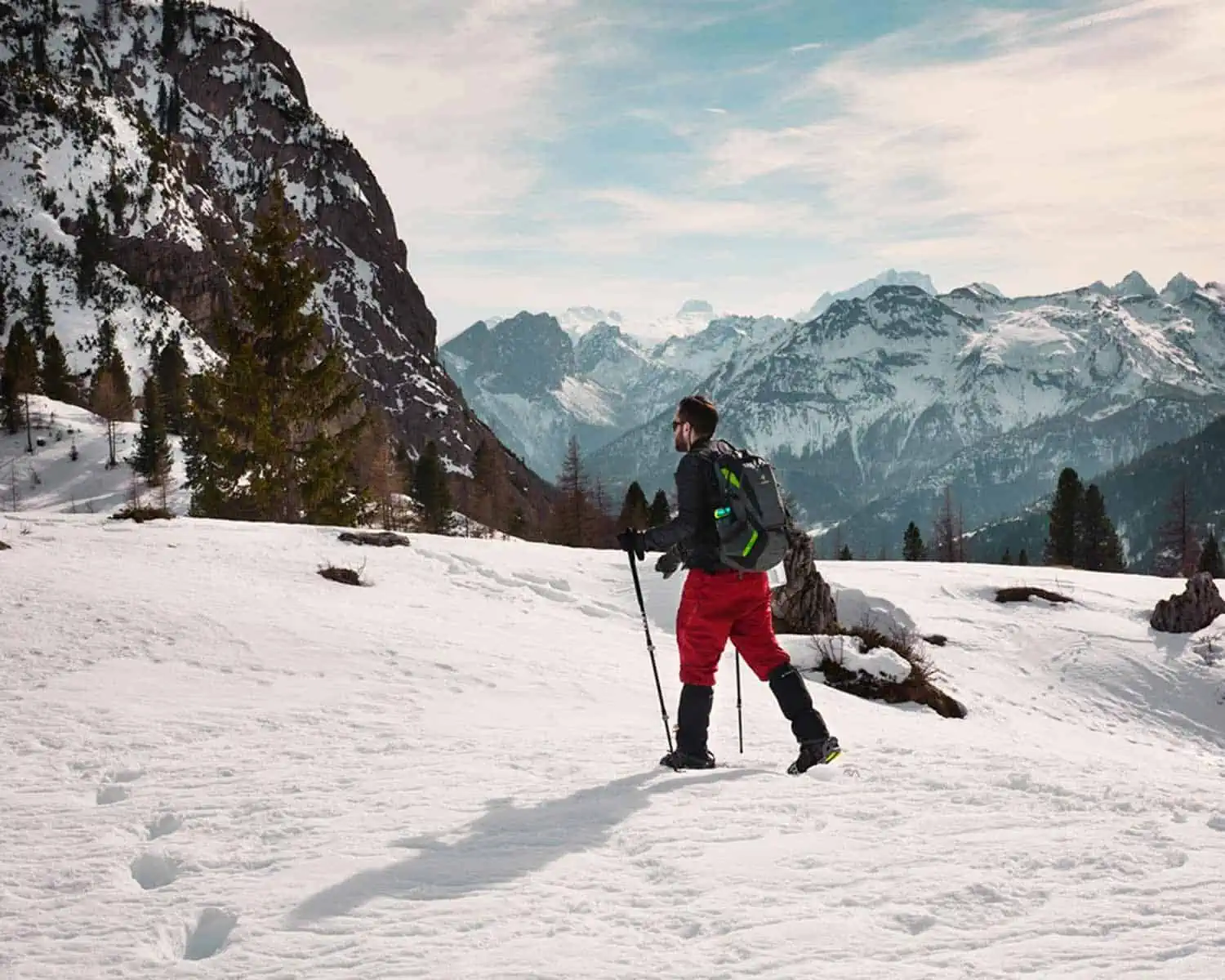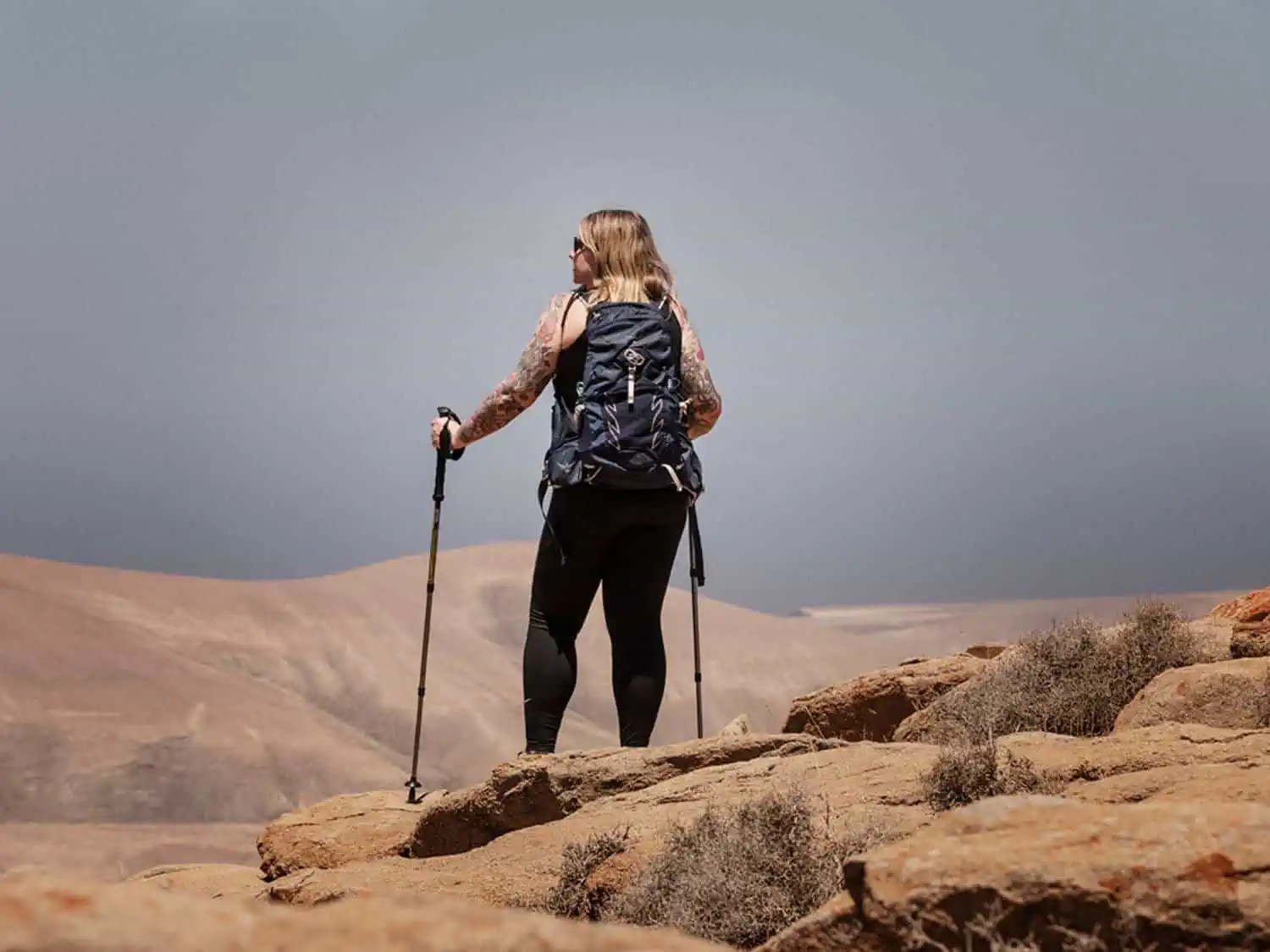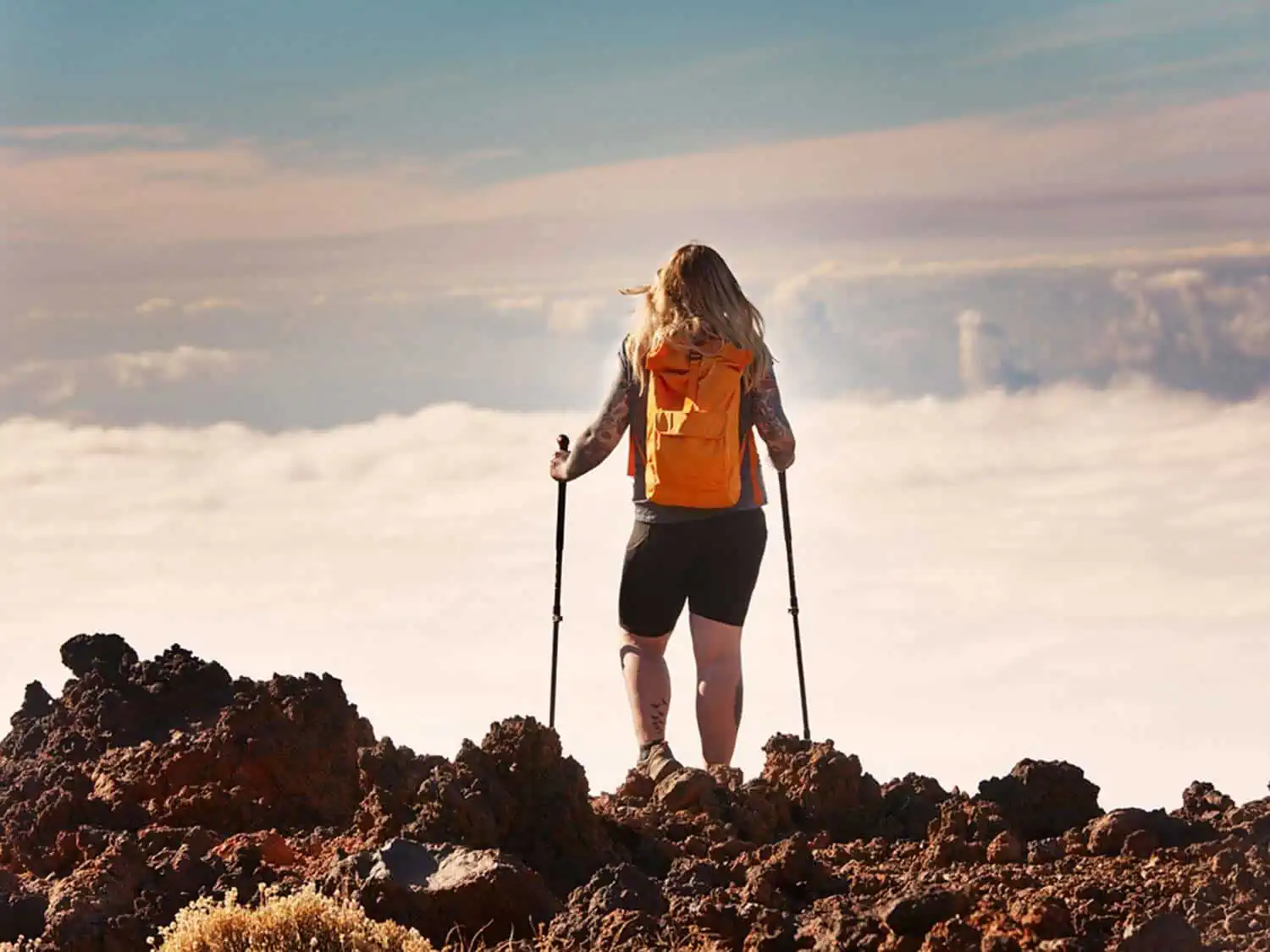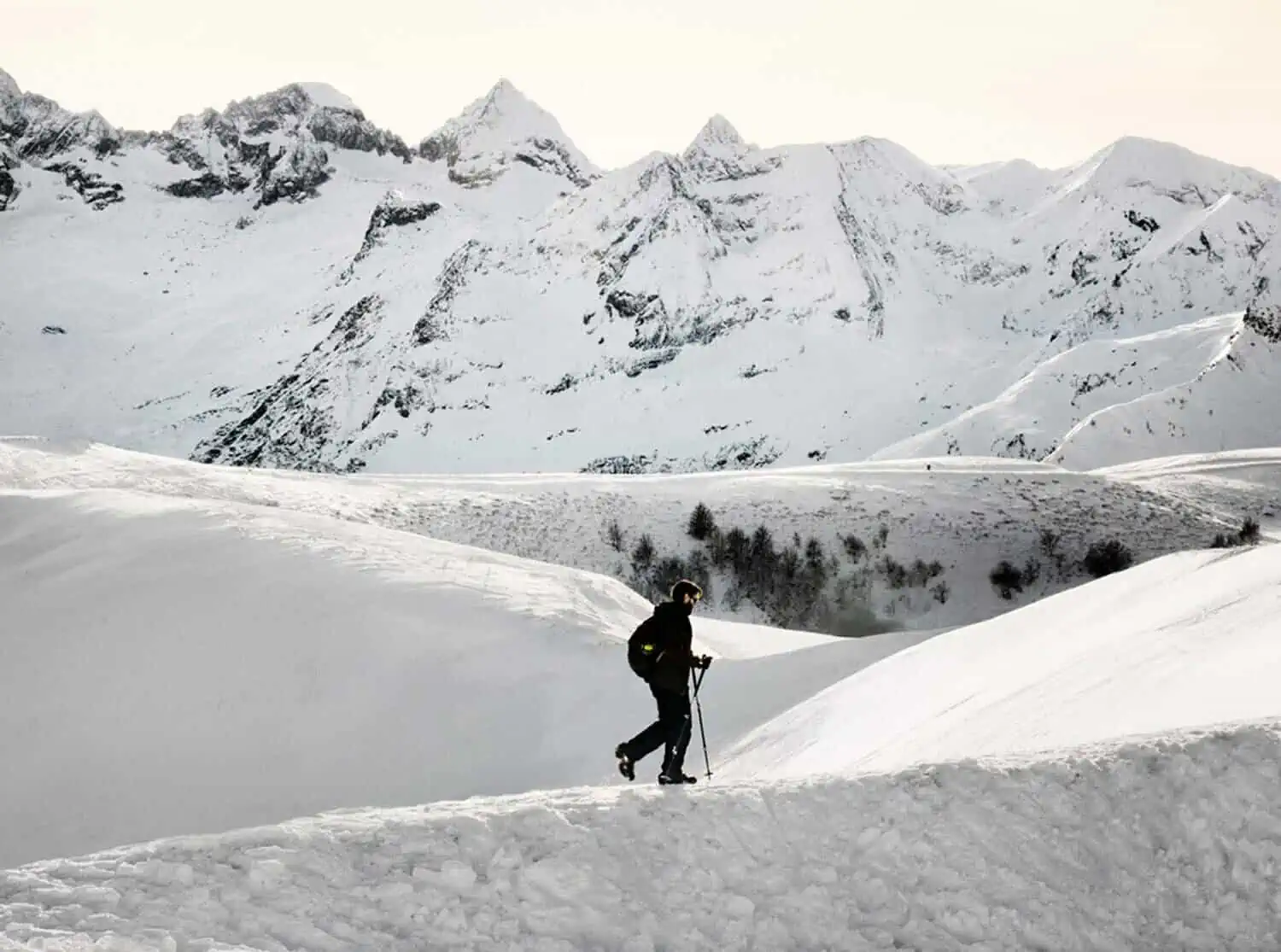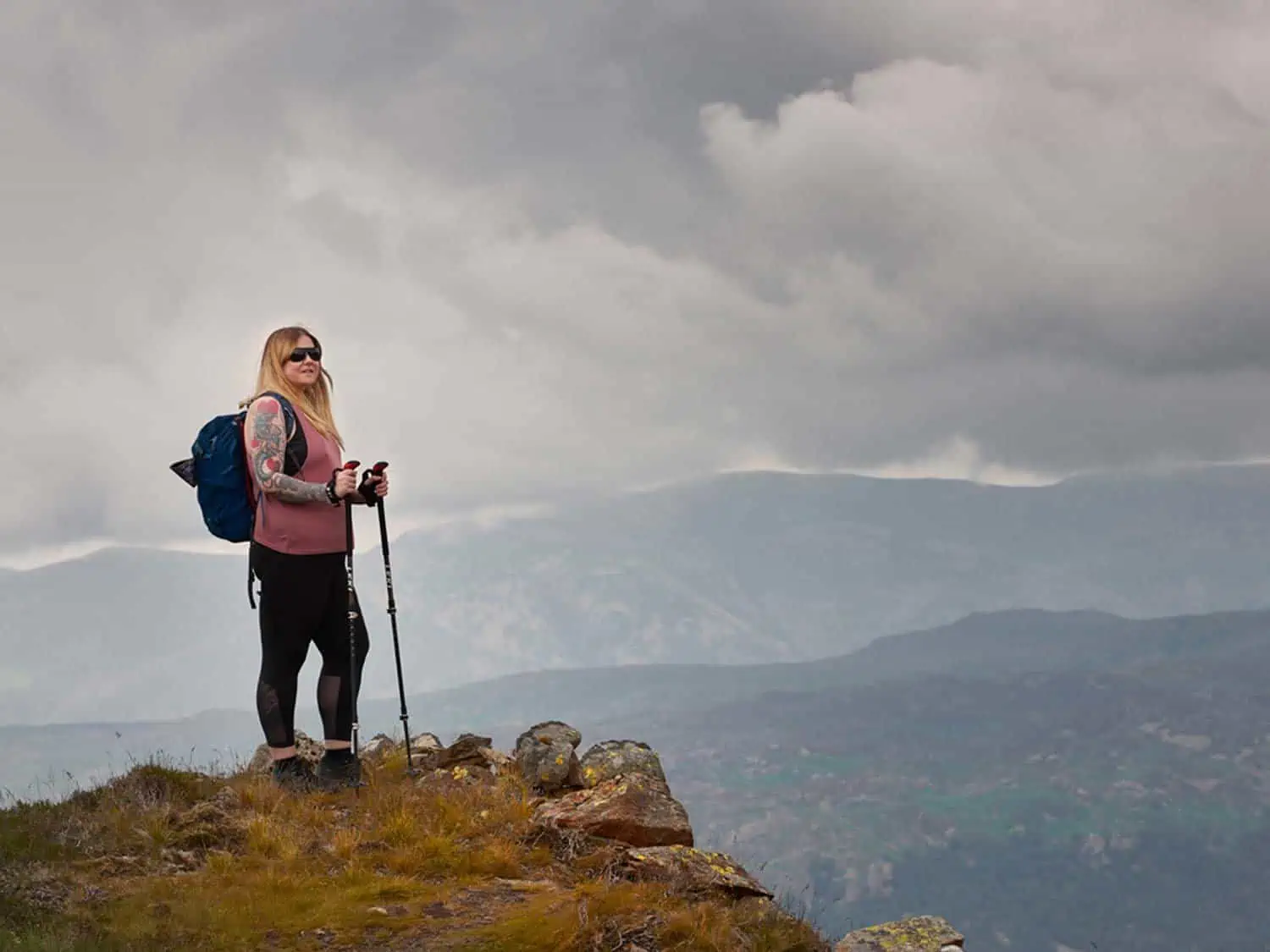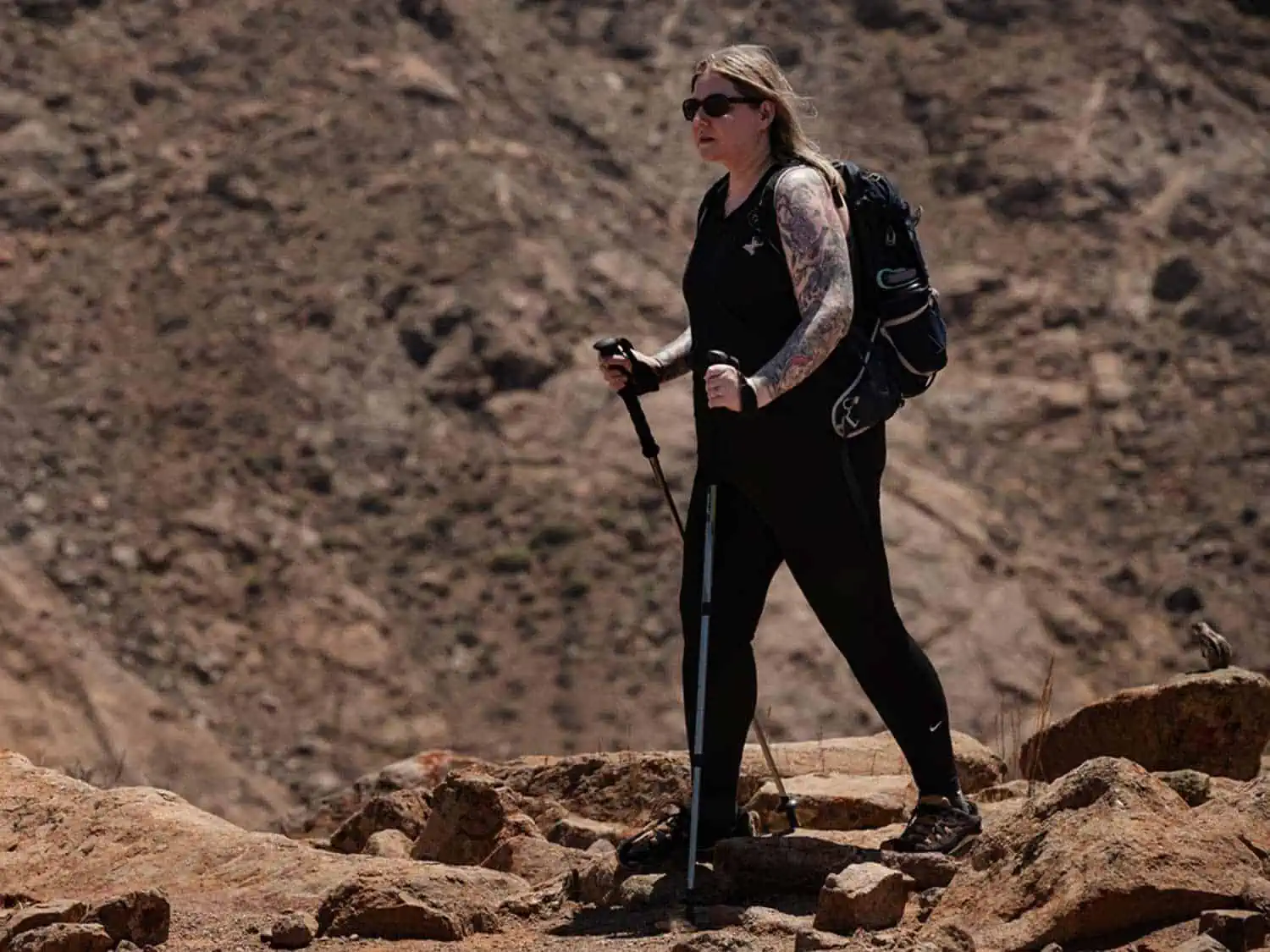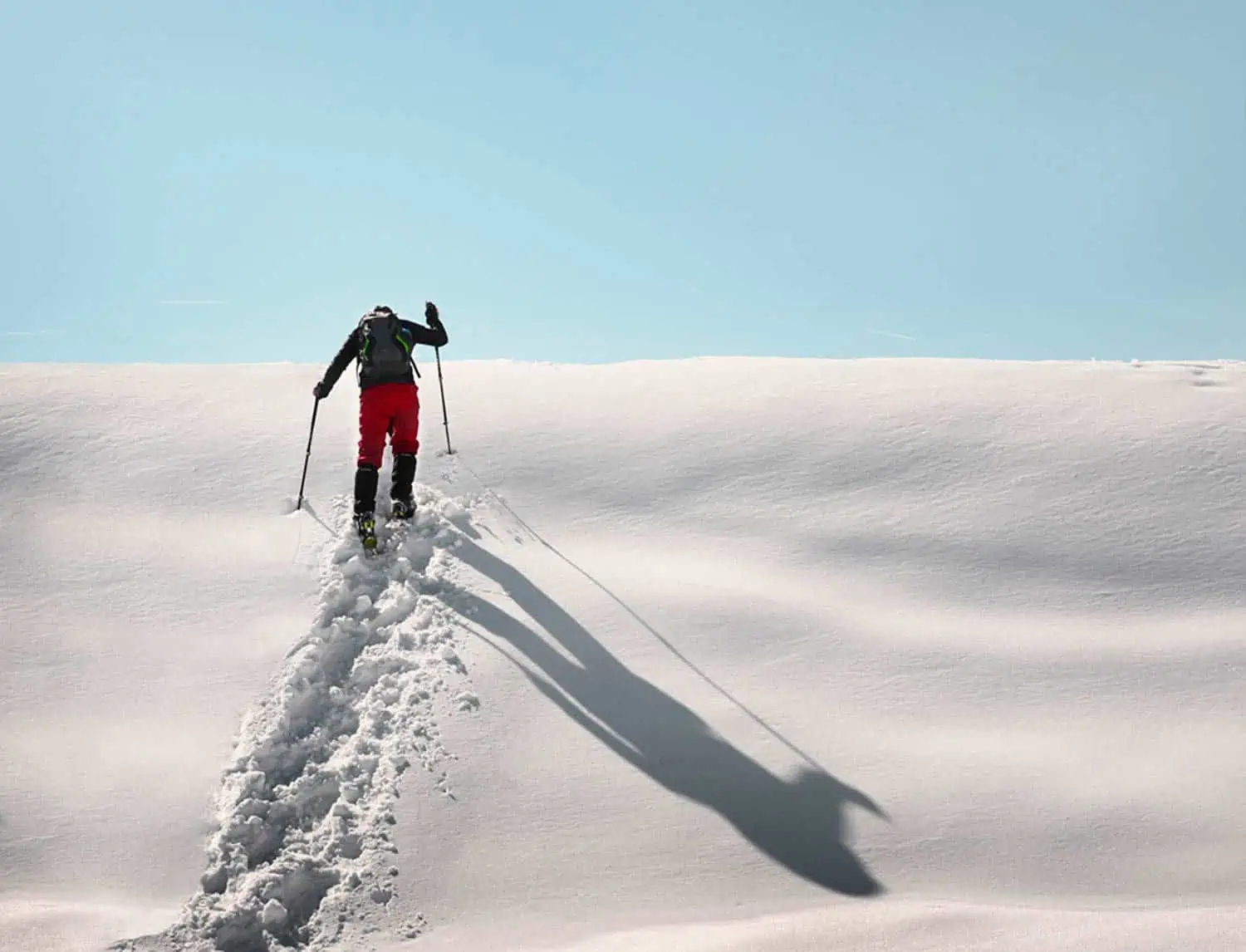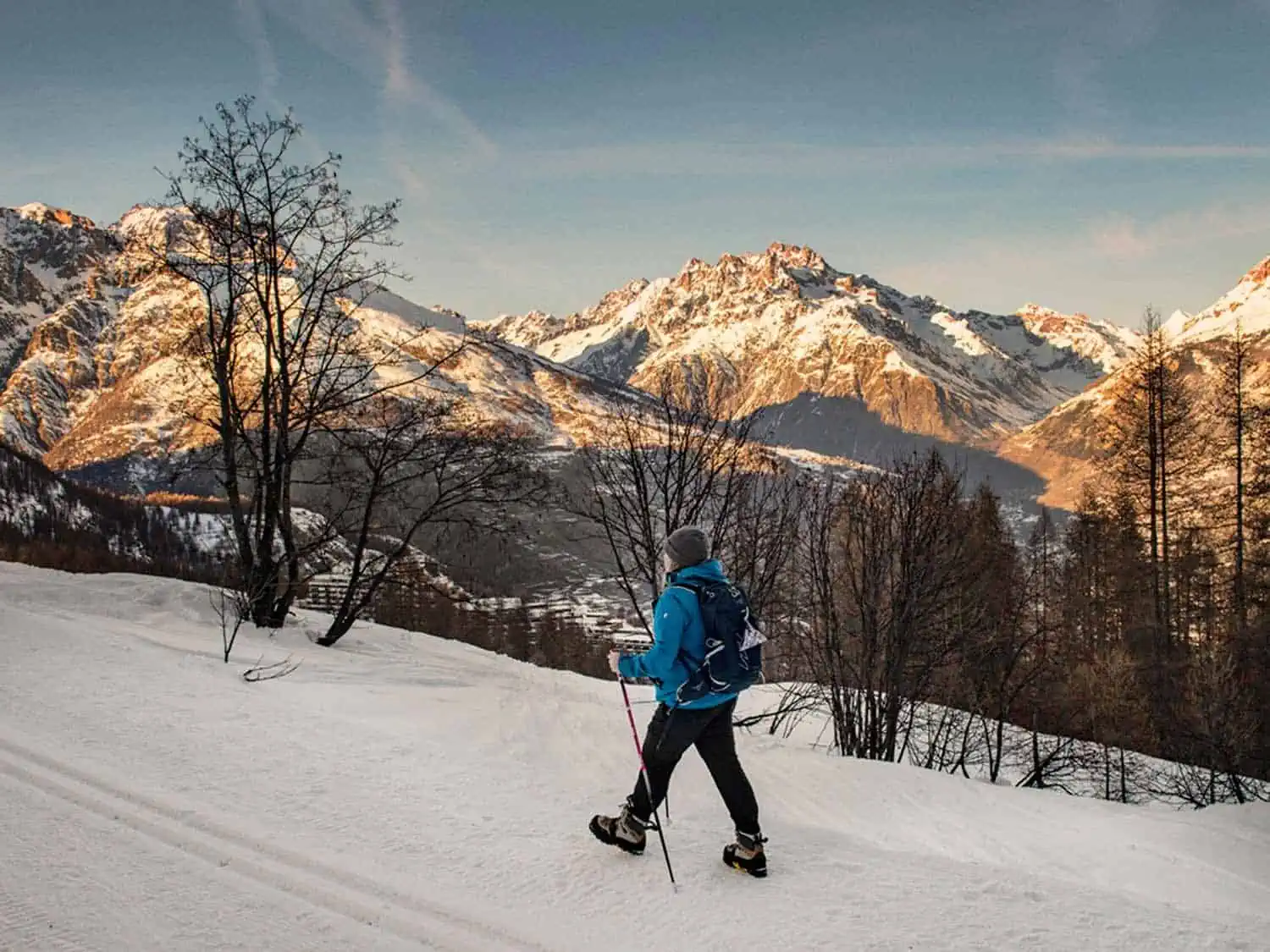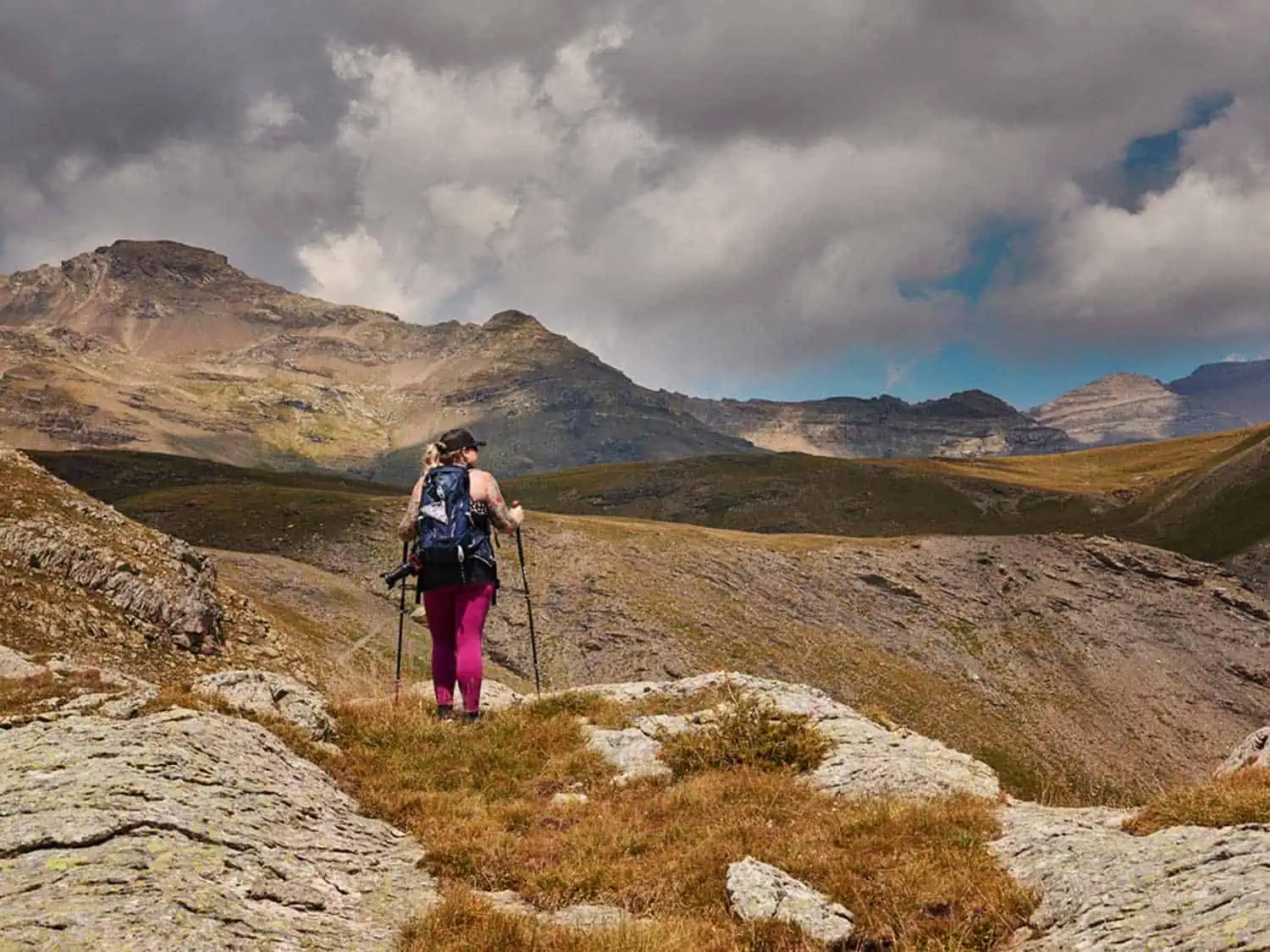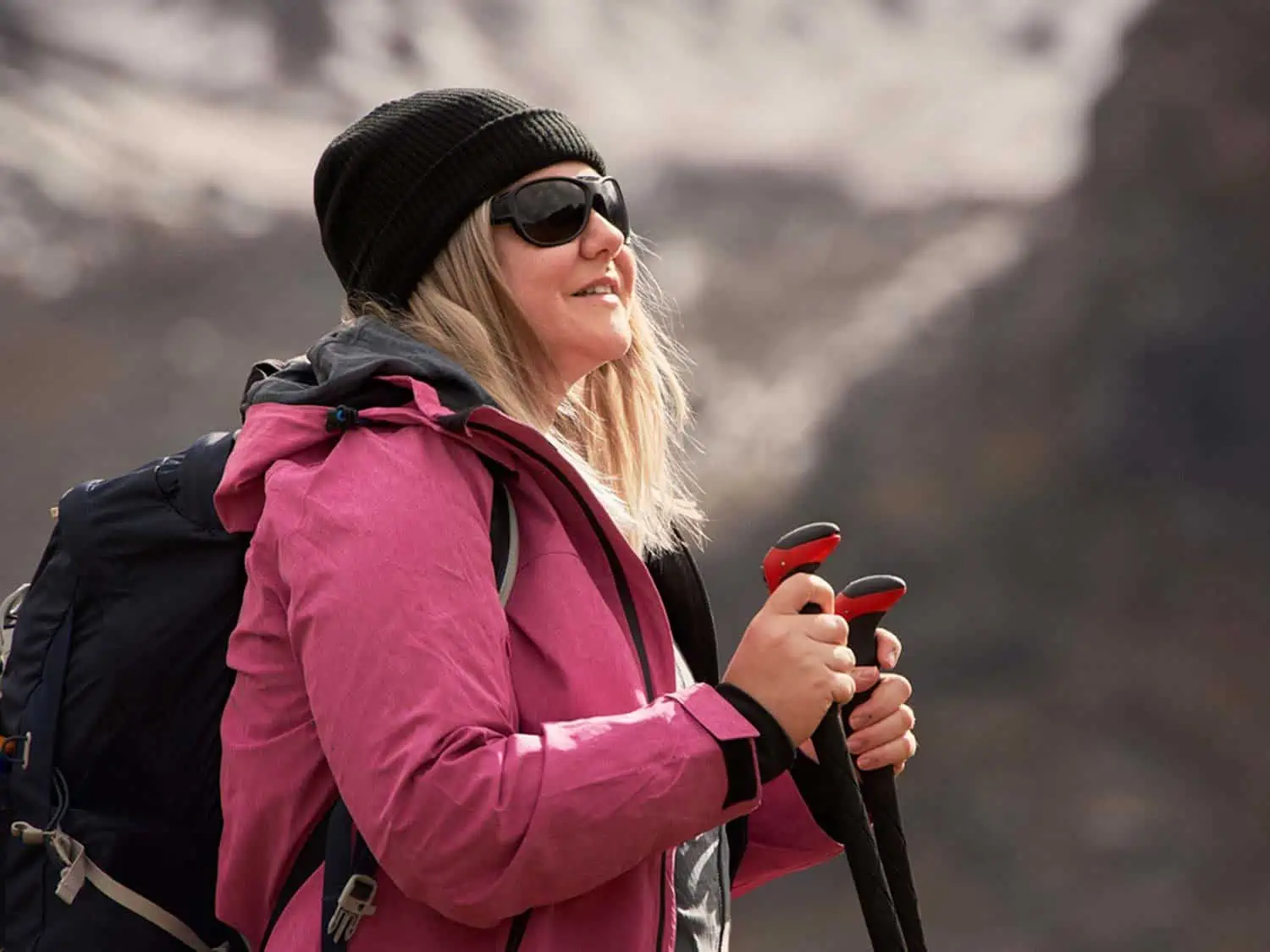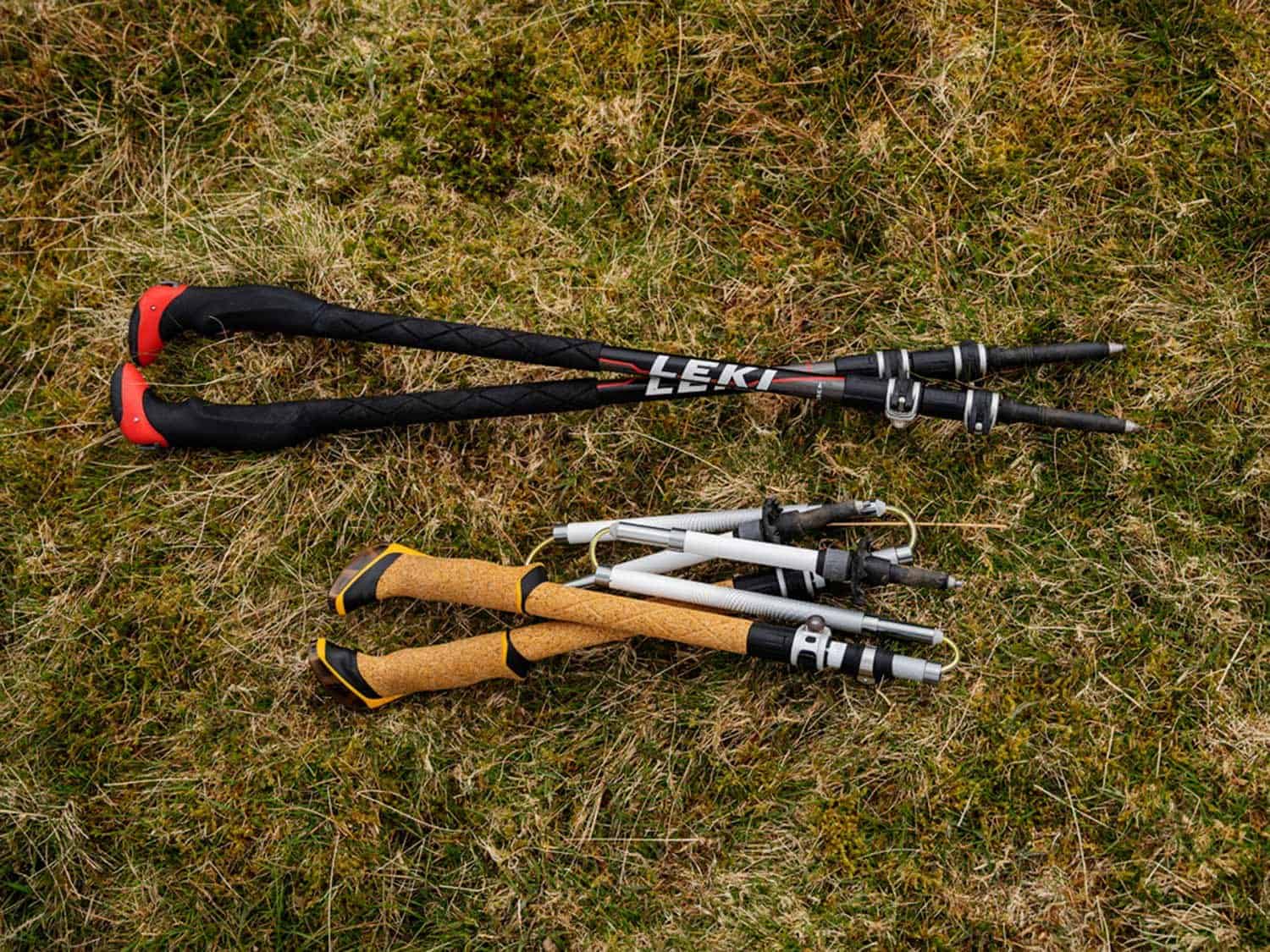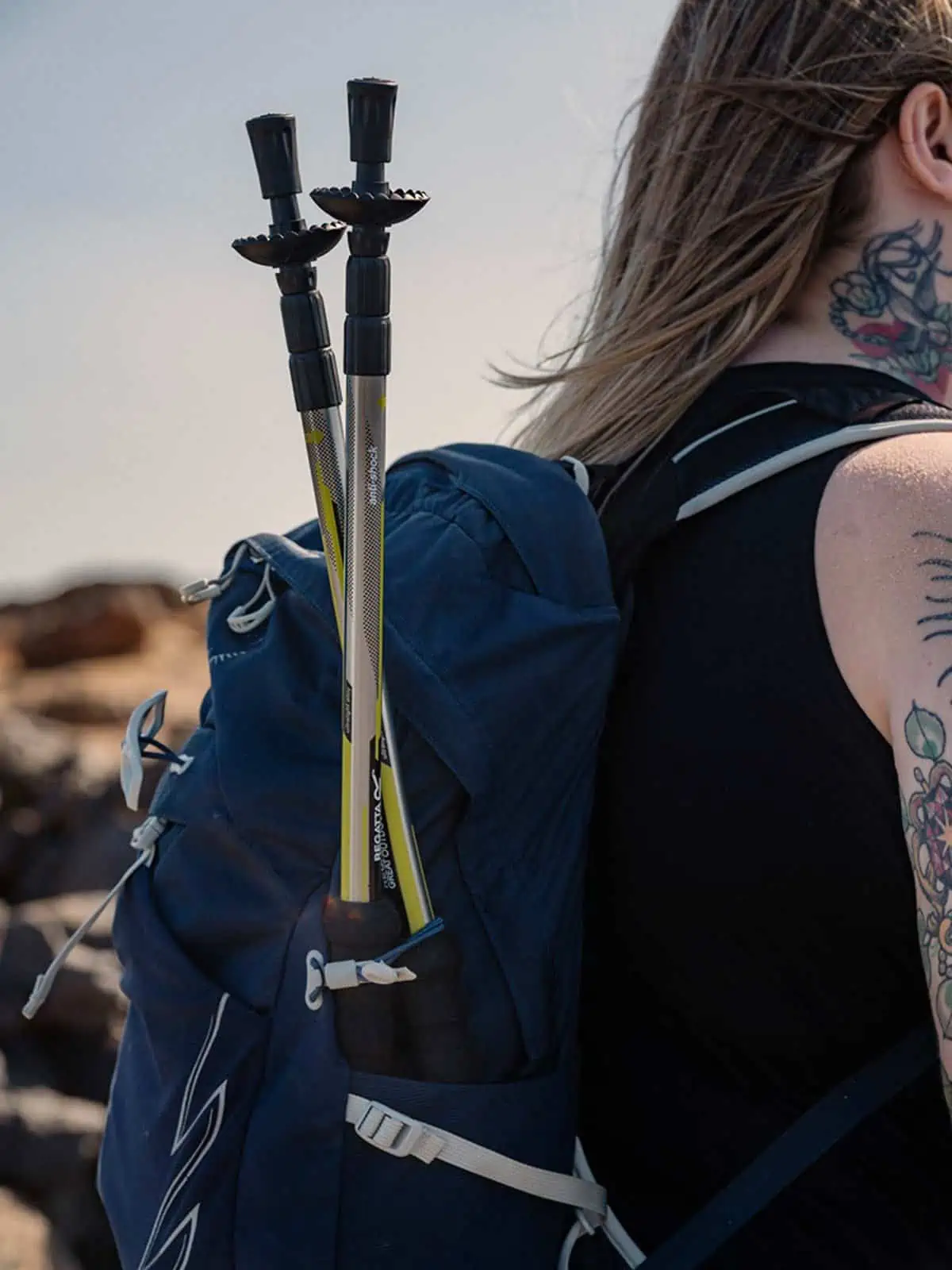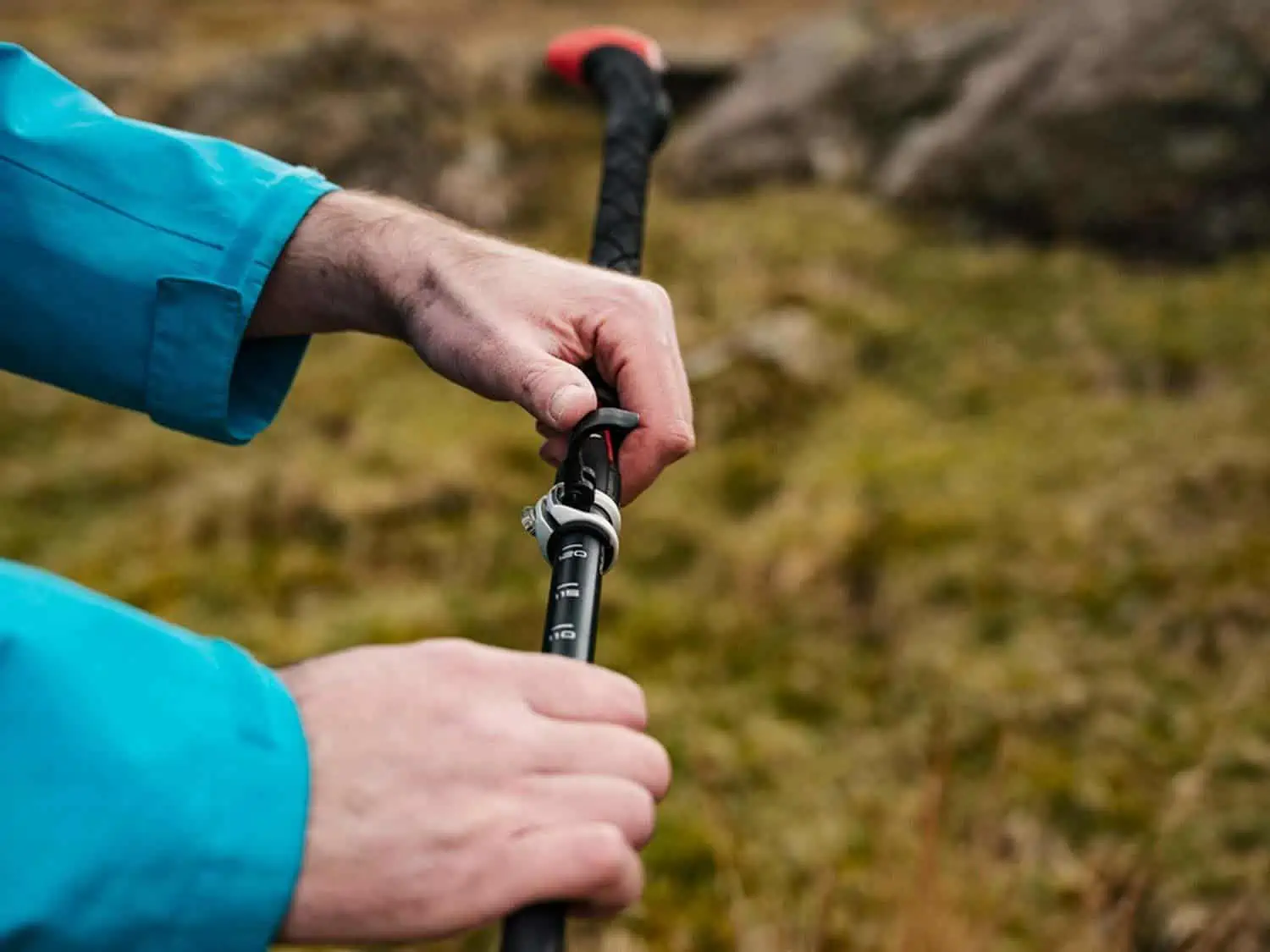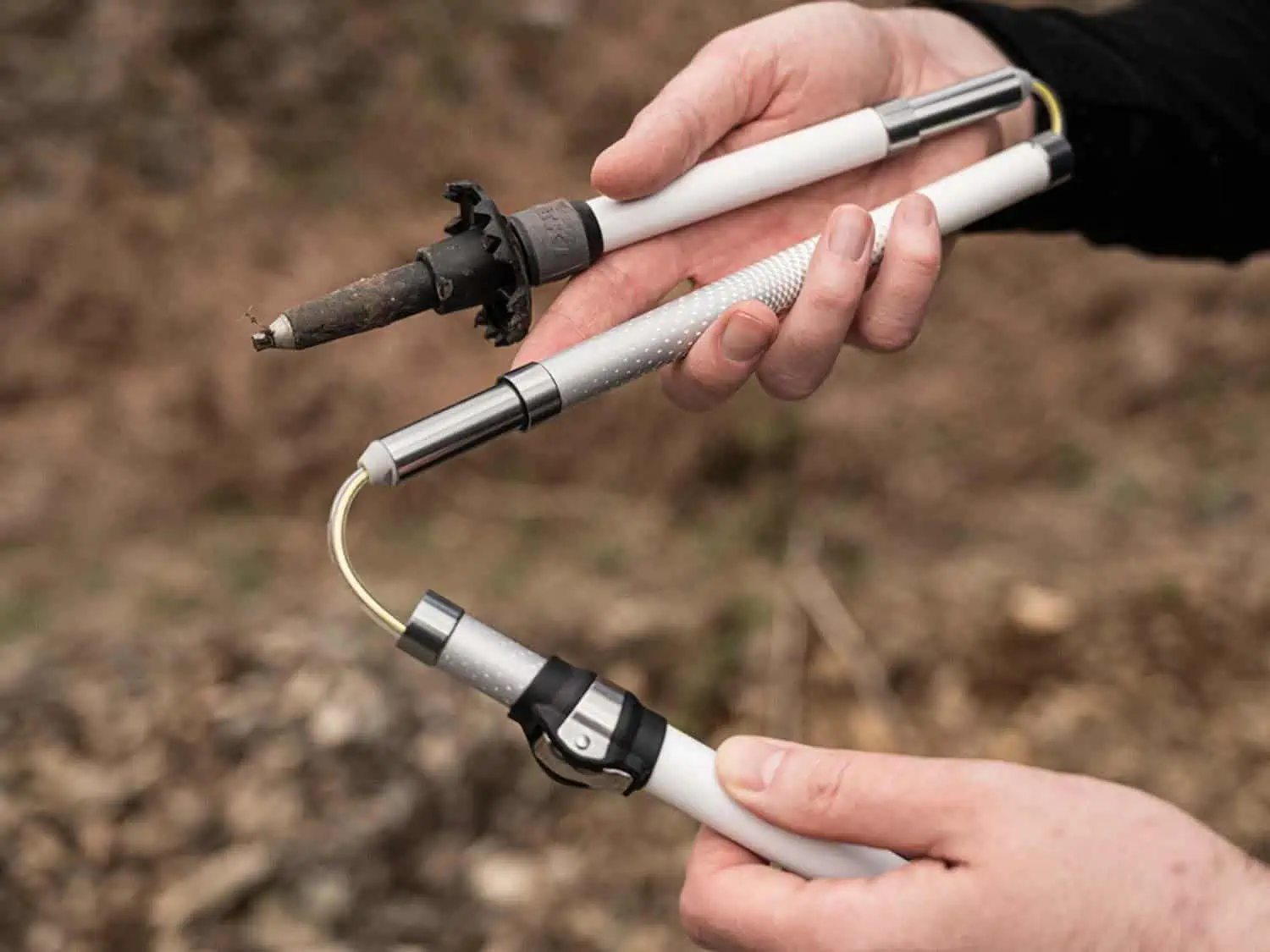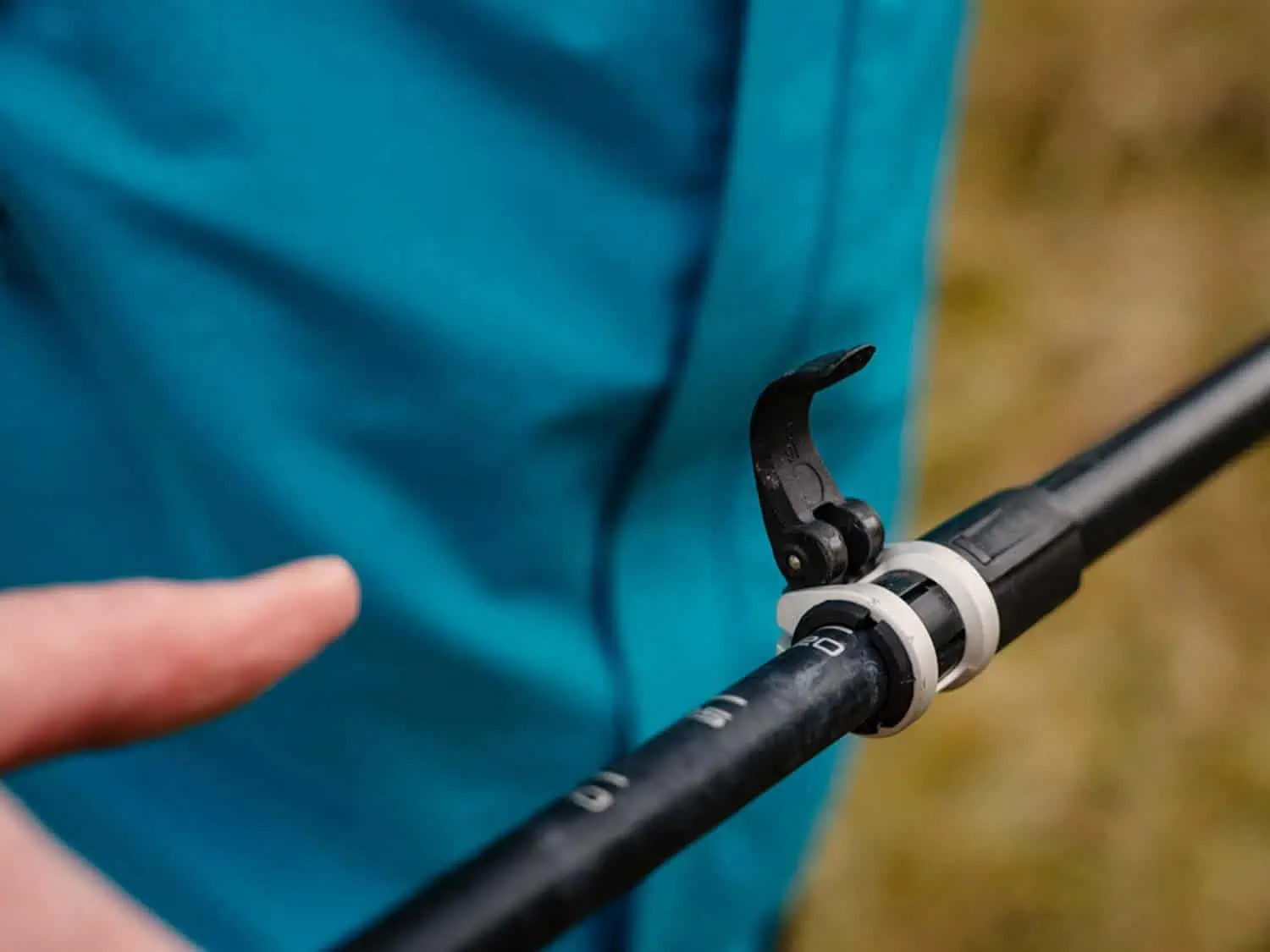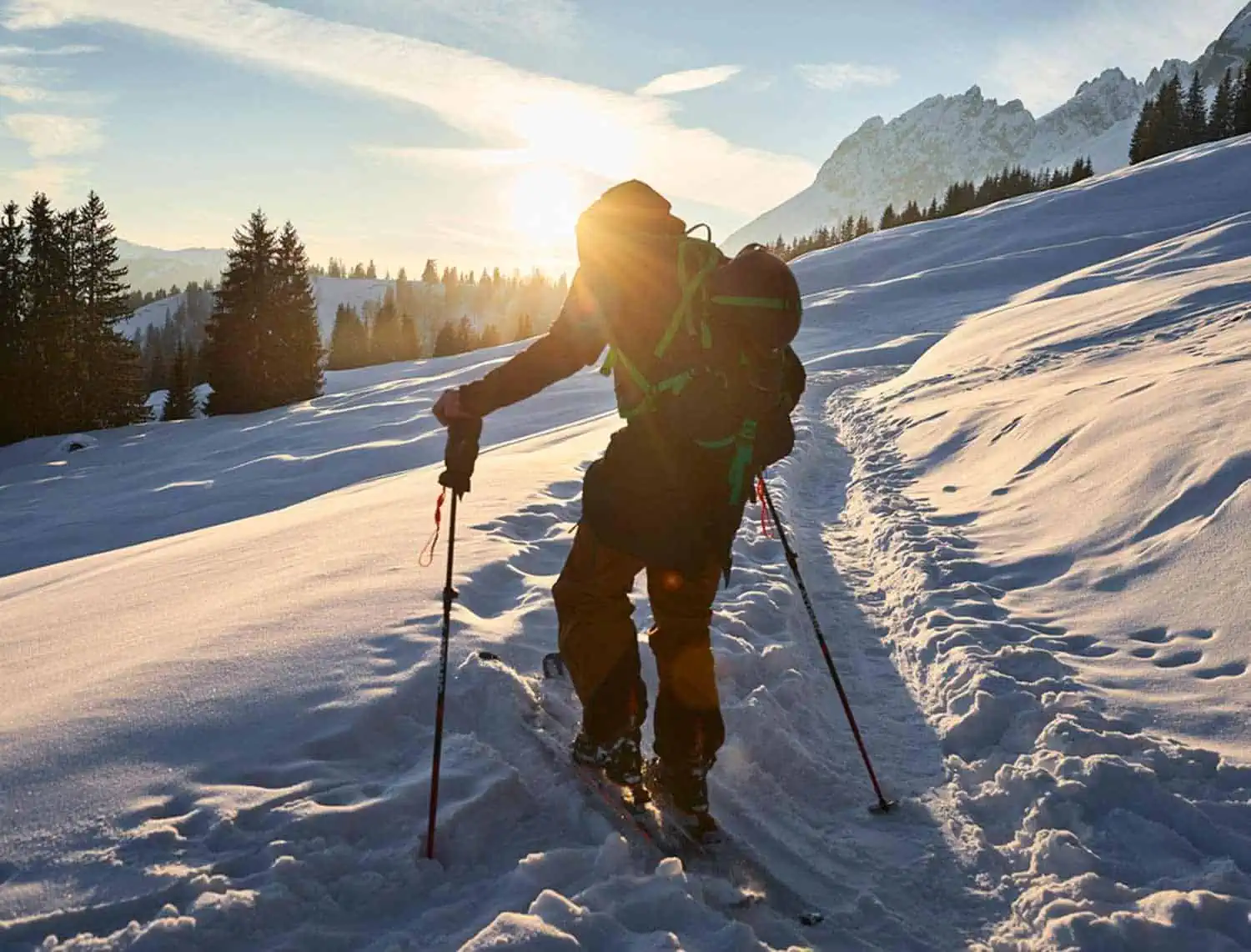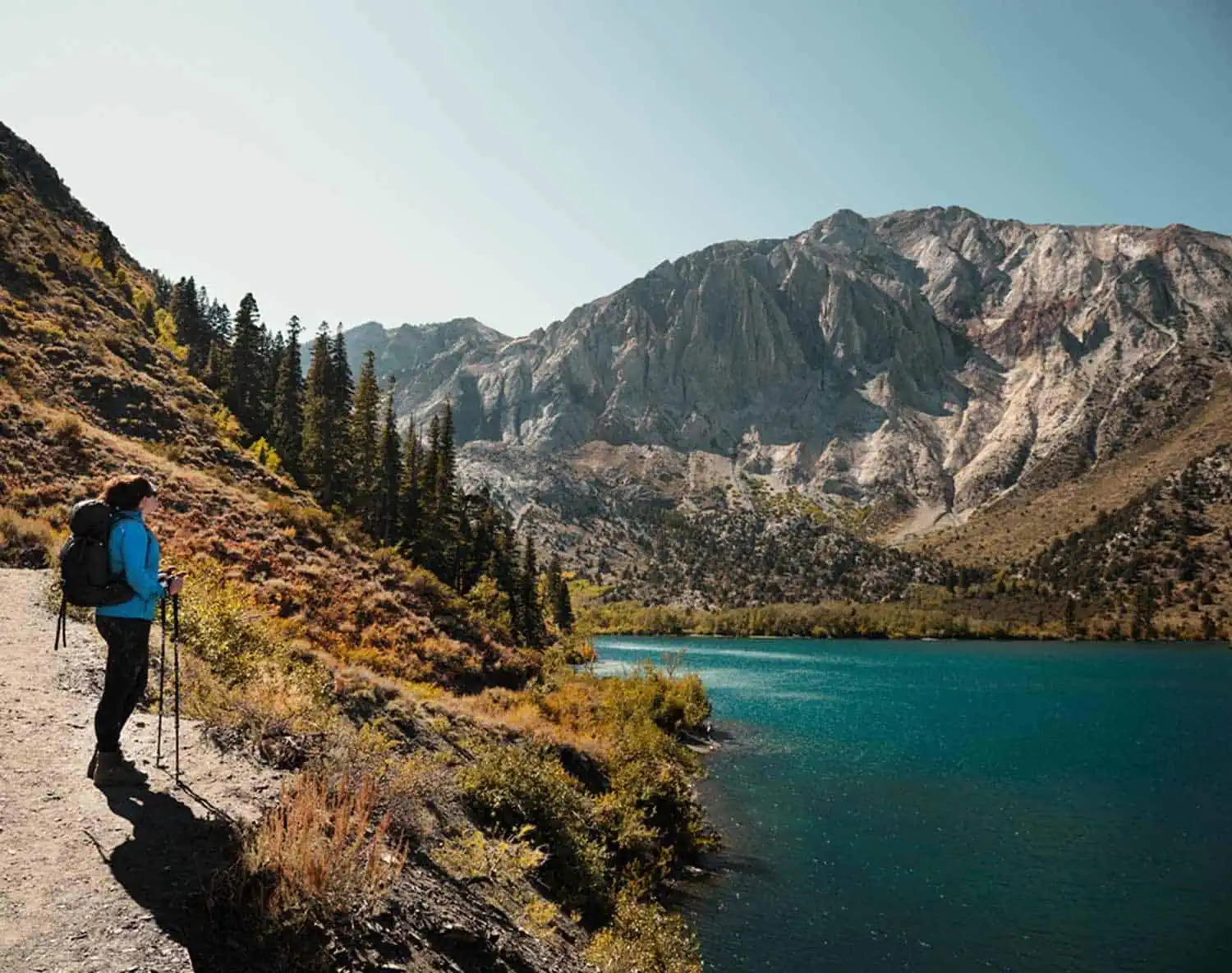Hiking poles are an often-overlooked accessory on the trail. Many hikers – especially those who are new to the scene – associate poles with mobility aids and think they are only useful to those with mobility issues. Whilst this is one definite and valid usage case for poles, it’s also very far from the full picture and there’s a great case to be made for making hiking poles an essential and permanent addition to your hiking kit. Put simply, trekking poles help hikers move through the landscape more efficiently. They help you keep your balance as you navigate tricky terrain. They’re a fantastic aid when crossing streams and also really helpful on steep ascents and descents. Trekking poles also help disperse the load on your joints caused by both your body weight plus the weight of any equipment you’re carrying. If you’re trekking with a heavy gear-loaded backpack, a set of poles can really ease the load on your knees helping you to hike comfortably for longer.
Throughout this round-up we’ll refer to poles as hiking, trekking and walking poles or sticks. Whilst you can split hairs about definitions, for our purposes, all these descriptions refer to the same thing – though obviously, some poles are more suitable for, or even specifically designed for, certain kinds of activities than others. We’ve highlighted this in our reviews where it’s relevant.
So, if you’re new to the world of trekking poles or want to explore what options exist for your next set of hiking sticks, be sure to read our round up to get the low down on some of the best options out there to suit all budgets and requirements.
Editor’s note: This article is part of our guide to the very best trekking poles of 2024, be sure to check out the rest of this guide for our top buying tips:
Our 12 Top Trekking and Hiking Poles
Our round up of 12 top trekking and hiking pole recommendations taking into consideration price, performance, durability, usability, seasonality.
In Brief:
Trekking Pole | Buying Options | Construction | Primary Material |
Leki Makalu FX Carbon AS | Folding (three section) with single telescopic section | Carbon Fiber | |
Leki Cressida FX Carbon AS | Folding (three section) with single telescopic section | Carbon Fiber | |
Leki Sherpa | Telescopic (three section) | Aluminum | |
Regatta Utralite Walking Pole | Telescopic (three section) | Aluminum | |
Leki Black Series FX Carbon | Folding (three section) with single telescopic section | Carbon Fiber | |
MSR DynaLock Ascent Foldable Carbon Backcountry Trekking Poles | Folding (three section) with single telescopic section | Carbon Fiber | |
Black Diamond Alpine Carbon Cork | Telescopic (three section) | Carbon Fiber | |
Black Diamond Distance Carbon FLZ Hiking Poles | Folding (three section) with single telescopic section | Carbon Fiber | |
Black Diamond Trail Back Poles | Folding (three section) with single telescopic section | Aluminum | |
Black Diamond Trail Ergo Cork Walking Poles | Telescopic (three section) | Aluminum | |
TheFitLife Carbon Fiber Trekking Poles | Telescopic (three section) | Carbon Fiber | |
Trekology TREK-Z Walking Poles | Folding (three section) with single telescopic section | Aluminum |
#1 Best Trekking Pole Overall
Leki Makalu FX Carbon AS Trekking Pole

Pros / Reasons to Buy
- Very compact folded size
- Replacement parts are available
Cons / Reasons to Avoid
- Expensive
- Limited adjustment range
The Makalu FX Carbon AS is one of Leki’s top-end folding models. These trekking poles are not cheap, but they are beautifully finished and pack a lot of Leki’s latest tech to help improve your comfort on the trail including their latest Aergon Air anatomic and shock-absorbing grip, plus the ‘AS’ anti-shock joint near the tip. Using a folding design, they have a very compact packed size but, on the flipside, they do not have the range of extension you might expect from a more traditional telescopic hiking stick. Also, the shock-absorbing tech definitely adds some weight to these Leki trekking poles and this eliminates some of the weight advantage you usually see with carbon fiber trekking poles. All this said, we don’t think the poles feel heavy and they are certainly comfortable to hike with. Leki are one of the best-known names in the hiking pole business and they offer readily-available spare parts, which means their poles can generally be repaired if a component wears out or gets damaged. Whilst some hikers – and particularly those who head into very extreme environments – may prefer aluminum poles over carbon fiber for durability reasons, these Leki trekking poles are a great choice for general hiking and trekking.
We’ve also reviewed the slightly shorter Leki Cressida FX Carbon AS. This is essentially the same pole as the Makalu, but it’s marketed as a women’s version. These two Leki trekking poles are basically the same, but the Cressida offers a slightly shorter range of adjustments which would make it a better choice for smaller-framed hikers regardless of gender (They’re also different colors and whilst it’s a personal choice, we also prefer the Cressida’s color scheme). Whilst the Makalu and Cressida have the same recommended retail price, you can sometimes find the Makalu on sale for less at retail, so unless you specifically need the Cressida’s shorter length, we think the Makalu is a better buy. Read our full review of the Leki Makalu FX Carbon AS here.
#2 Best Trekking Pole for Overall Looks and Spec
Leki Cressida FX Carbon AS Trekking Pole
Pros / Reasons to Buy
- Very compact folded size
- Easy availability of replacement parts
Cons / Reasons to Avoid
- Expensive – and sometimes even priced at a premium over the largely identical Makalu
- Limited adjustment range
The Leki Cressida FX Carbon AS is marketed as a women’s version of the Makalu FX Carbon AS which we’ve assessed elsewhere in this roundup. Apart from a different color scheme and a slightly different range of extended lengths (the Cressida is shorter than the Makalu – though there is some overlap), the two models are essentially the same, so everything we’ve said for the Makalu is valid here! Essentially, these are top-quality folding trekking poles that sits near the top of Leki’s range of trekking poles. These Leki trekking poles aren’t cheap, and indeed they sometimes carry a price-premium at retail over the Makalu, but they offer fantastic build quality and finish, premium materials and range of features intended to improve your comfort whilst trekking, including Leki’s latest Aergon Air ergonomic and shock-absorbing grips and an ‘AS’ anti-shock joint near the tip.
Gendered versions aside, this isn’t just one of the best trekking poles for women, but also a great choice for any hiker with a smaller frame who might find the extension range of the Makalu to be too long. The slightly shorter maximum length means these Leki trekking poles can be a little lighter than the Makalu, though there are better options out there if absolute low weight is your priority. In use, these Leki hiking poles are super-comfortable and stow down to a compact size. We thoroughly recommend them. Read our full review of the Leki Cressida FX Carbon AS here.
#3 Best Trekking Poles for Mountaineering and robust build
Leki Sherpa Trekking Poles
Pros / Reasons to Buy
- Rock-solid build
- Most versatile in terms of adjustment range
Cons / Reasons to Avoid
- Heavy
- The longest poles in our round up when collapsed
The Leki Sherpa is a rock-solid aluminum, three-section telescopic hiking stick from one of the key players in the hiking pole business. It’s aimed at mountaineers and those exploring harsh conditions, and this is reflected in its extra-tough build and wide range of adjustability. On the downside, these hiking sticks are heavy and are the least compact when folded in our round-up. These poles don’t have the anti-shock features found in some of Leki’s other poles, but if you’re hiking with a heavy expedition pack and/or using these poles to lever your full weight up a steep ascent or steady you on an even steeper descent or stream-crossing, then the more ‘positive’ feedback you’ll get from a fully rigid pole is probably something most hikers would consider a positive point.
We’ve personally used a slightly older and now discontinued version of these Leki trekking poles for a number of years, and these hiking sticks are basically an updated version, similar in many ways, and whilst they’re probably overkill for most of what we do, they’re also totally dependable and we think they’re amongst the best trekking poles out there. Leki also offer spare parts that are readily available in larger outdoors stores so, should something eventually wear out or get damaged in use, the poles can likely be repaired and brought back into service. With this in mind, we’ve got no doubt that these poles cold last you a very long time indeed and likely even a lifetime. Read our full review of the Leki Sherpa trekking poles here.
#4 Best for Cost to Performance Ratio
Regatta Ultralite Walking Poles
Pros / Reasons to Buy
- Fantastic price!
- Solid build
Cons / Reasons to Avoid
- Twist locks can be fiddly
- Not the lightest
If you’re into the outdoors and live in the UK, there’s a good chance you’ve owned a piece of Regatta equipment or clothing at some point: they are a long established brand who squarely target the budget end of the market. Their Ultralite Walking Poles are the least expensive walking sticks for hiking in our round up by a clear margin and we think they hit above their weight in terms of build quality and comfort. The negative points of these hiking sticks are that they are at the heavier end of products we’ve assessed, and they are also the only hiking poles we’ve assessed that use twist locks on the leg sections. Whilst the Regatta twist locks are a substantial improvement on some of the dreadful twist locks we’ve encountered on walking poles in the past, we still generally prefer flip locks. However, we think these negative points are minor when considered next to these hiking sticks’ plus points.
The Regatta Ultralite Walking Poles are certainly well-built telescopic aluminum hiking sticks. They feel very solid and we don’t doubt they could last for a very long time indeed. They also have a springy anti-shock feature that will do a great job of absorbing impact and vibration on the trail. Those who are using their hiking sticks to navigate more technical terrain may favor the more positive feedback that comes from a more rigid hiking stick, but for less intense trekking and general hiking or walking, these Regatta hiking sticks are very comfortable and impress even more when you consider their very low price. If you’re on a tight budget, don’t want to spend Read our full review of the Regatta Ultralite Walking Poles here.
Best of the Rest
#5 Leki Black Series FX Carbon Trekking Poles
Pros / Reasons to Buy
- Ligthweight
- Replacement parts are available
Cons / Reasons to Avoid
- Lacks the anti-shock technology of heavier Leki folding poles
- Expensive
Leki is one of the key names most people will associate with trekking or hiking poles and the Black Series is one of their highest-end premium offerings. It combines fantastic build quality with high end materials and low weight, though, as you might expect, this does come with a high price tag. Relative to the other three section collapsible folding Leki hiking poles we’ve assessed in this round up, these Black Series Carbon poles are slightly lighter, feature a natural cork grip which will mold to your hand shape over time (and some buyers will surely prefer this over a high-density foam grip) alongside a slightly lower weight. However, they also lack the ‘AS’ anti shock joint that’s present on the Cressida and Makalu – though we’re sure that many potential buyers of these Leki hiking poles will overlook this in favor of the lower weight. All in all, these carbon fiber trekking poles are a great choice for those looking for a light weight all-round poles and who don’t mind paying a premium for some of the best quality available. Read our full review of the Leki Black Series FX Carbon trekking poles here.
#6 MSR DynaLock Ascent Foldable Carbon Backcountry Trekking Poles
Pros / Reasons to Buy
- Solid build
- Lightweight when considered alongside their maximum extension
Cons / Reasons to Avoid
- Long collapsed length
- Pricey
MSR is not a name that many would associate with hiking or trekking poles, but it can’t be denied that the company has a well-earned reputation for making high quality and innovative outdoors equipment, so it seems natural that they’d offer trekking poles in their range. These folding or collapsible trekking poles are certainly interesting: we’ve focused on the long variant that MSR offers which gives a longer than average maximum extended length for a folding pole. This feature may appeal not just to taller hikers, but also those who regularly adjust their poles to longer lengths – on steep descents or when crossing streams etc. Whilst these folding or collapsible trekking poles are not the lightest in our round up, when you consider their weight alongside their length, they offer a great combination. MSR have also incorporated Kevlar reinforced carbon fiber into these poles which promises to be extra-tough. These hiking sticks are not cheap, but they pack a lot of innovative features and clever design touches (for example MSR integrate a hook for setting and releasing your snowshoe lift into both the grip and snow basket of these poles). We think they are well worth a look! Read our full review of the MSR DynaLock Ascent Foldable Carbon Backcountry Trekking Poles here.
#7 Black Diamond Alpine Carbon Cork Hiking Poles
Pros / Reasons to Buy
- Spare parts are readily available
- Whippet attachment will appeal to some buyers
Cons / Reasons to Avoid
- Pricey
- A tool is required to adjust flip lock tension
Black Diamond, along with Leki is probably one of the key names most people will think of when considering the best hiking poles. These carbon fiber trekking poles utilize a more traditional telescopic design rather than the folding design you increasingly see at the high end of the market. Whilst not as compact as folding trekking poles when packed down, these Black Diamond trekking poles make up for this with a longer range of adjustment, and some buyers will surely prefer the simpler telescopic design and if this is you, these are a great high-end choice offering premium materials like carbon fiber in the pole shafts and natural cork on the upper section of the grips which will mold to your hand shape over time.
One unique feature of these Black Diamond trekking poles is that they are ‘Whippet Ready’. The Whippet is Black Diamond’s name for an optional accessory like the head of an ice axe and, whilst Black Diamond clearly state these poles plus Whippet attachment are no substitute for an actual ice axe when mountaineering or climbing, the attachment makes the poles more usable should you suffer a fall on the snow and need to self-arrest. This is a niche feature, but it could also be enough to seal the deal for some buyers. However, even if you have no interest in the Whippet feature, these Black Diamond trekking poles are still, we think, a great option for general hiking and trekking. They are beautifully and solidly built and come with all the quality you’d expect from Black Diamond. The only major downside is that adjusting the tension on the leg’s flip locks requires a small tool – a great shame when other manufacturer’s hiking poles allow this adjustment to be made tool-free. Read our full review of the Black Diamond Alpine Carbon Cork hiking poles here.
#8 Black Diamond Distance Carbon FLZ Hiking Poles
Pros / Reasons to Buy
- The lightest poles in our round up
- The most compact folded poles in our round up
Cons / Reasons to Avoid
- There may be some long-term durability concerns
- Tool required to tension flip locks
The black Diamond Distance Carbon FLZ Hiking Poles are the lightest poles we’ve assessed in this round up. They will surely appeal to hikers who need (or simply just want!) the lightest possible gear and we think they’ll also appeal to trail runners – even those who might use these poles in competition. These Black Diamond trekking poles are a high tech folding pole, showcasing the peak of Black Diamond’s technical innovation and design skills. These Black diamond Trekking poles have a remarkably low weight, but they are also relatively pricey and offer a very limited adjustment range. They are offered in different lengths and given the limited adjustment range, ensuring you select the correct length is particularly important with these hiking sticks. These trekking poles make extensive use of carbon fiber and are built with lightness as a priority, so whereas other manufacturers reinforce the joins in their carbon fiber trekking poles with metal, that’s been skipped here to reduce weight – though measures like this certainly come at the expense of long-term durability.
As with other Black Diamond trekking poles, a tool is required to adjust the tension on the flip lock on the poles – this is another (admittedly small and light) item to have to carry and it’s frustrating that Black Diamond haven’t moved on to tool-free adjustment for their flip locks as some of their competitors have. Many hikers looking for solid, general purpose trekking poles will likely bypass these – they are clearly a specialist model – but if you’re after ultralight trekking poles that you’ll perhaps also use on runs, then these folding ultralight trekking poles from Black Diamond are a great choice. Read our full review of the Black Diamond Distance Carbon FLZ Hiking Poles here.
#9 Black Diamond Trail Back Poles
Pros / Reasons to Buy
- Budget choice form a respected brand
- Solid build
Cons / Reasons to Avoid
- Quite basic in terms of design
- A tool is required to adjust flip lock tension
Black Diamond are one of the first names many people will think of when considering hiking poles and beyond this they have a fantastic reputation for making high quality outdoors gear and equipment. The other Black Diamond hiking sticks we’ve assessed are all relatively pricey, so it’s good to see that they also have options for the more budget-conscious user. These Trail Back hiking poles are outwardly a fairly no-frills offering: they use a very conventional aluminum telescopic construction and they don’t look as fancy as some of the other options out there. But, look closer and you’ll see they are a solid, well thought out product that uses tried and tested materials to deliver a product that’s surprisingly competitive in terms of its specification and which even beats some much more expensive alternatives in terms of weight and extension range.
Some may say these Black Diamond hiking poles are quite basic, but we think they encapsulate the ruggedness Black Diamond is known for at a very competitive price point. These poles may not have the tech or, dare we say it, bling factor of some others we’ve assessed, but they could also easily last you a lifetime – especially given that Black Diamond offer spare parts should anything get damaged or wear out. As with the other Black Diamond trekking poles we’ve assessed, these Trail Backs do require the use of the tool to adjust the flip lock tension – which is another item to have to remember to bring along- but aside from this, we think they are still an excellent choice for those who want a product from a big brand, reputable name, but who can’t or don’t want to spend so much on their poles. Read our full review of the Black Diamond Trail Back Poles here.
#10 Black Diamond Ergo Cork Walking Poles
Pros / Reasons to Buy
- You might love the angled hand grip
- Solid build
Cons / Reasons to Avoid
- You might hate the angled hand grip
- Not so compact when folded
These Black Diamond Ergo Cork hiking poles are a unique proposition. They utilize a fairly standard telescopic design, but their unique selling point is their angled hand grips which noticeably tilt forwards relative to most other poles available. These Black Diamond hiking poles are truly unique as we can’t find any other poles on the market that match this feature. Now, we think that a lot of potential buyers will either be indifferent to, or, at worst, actively dislike this feature, but for certain hikers – perhaps those with mobility issues in their hands or wrists or simply those who’ve tried but never really ‘got on’ with hiking poles, this angled grip position could be a real comfort revelation and could lead them to reassess their ideas about the comfort of walking sticks for hiking.
The angled grip is certainly a niche feature, and it comes with a penalty, not just in terms of price, but also size as these Black Diamond hiking poles can’t collapse as small as some other telescopic designs. However, if the angled grips make a difference for you, then any disadvantages go out the window and these poles could well be an essential purchase to help improve your comfort on the trail. Read our full review of the Black Diamond Ergo Cork Walking Poles here.
#11 TheFitLife Carbon Fiber Trekking Poles
Pros / Reasons to Buy
- Impressive feature set
- Very keen price
Cons / Reasons to Avoid
- Long term durability may be an issue
- Replacement parts are not available
If you saw a set of carbon fiber trekking poles with natural cork grips that weighed 400g/14oz for a pair from one of the ‘big name’ manufacturers, it’d be safe to assume it was a premium product with a high price tag. However, relatively unknown brand TheFitLife have taken this impressive list of premium materials and low weight and offered it at a very budget-friendly price point – in fact, these carbon fiber trekking poles are the third cheapest hiking sticks in our round up. These are conventional three-section telescopic poles. We do have some concerns about the long-term durability of these hiking sticks and we doubt you’d be able to source replacement parts if anything were to break or wear out. Some would argue that these carbon fiber trekking poles are cheap enough to simply replace if anything goes wrong, but we’ll leave it up to your own sense of sustainability as to whether you think that’s OK or not.
These walking poles could be a good choice for you if you want something with low weight but don’t have the budget for the ultralight offerings from the big name brands. To add to the value proposition, TheFitLife bundle these hiking sticks with an extensive accessory kit comprising different baskets and a variety of different tips. You’d have to pay extra for these from most other manufacturers, so this is great to have included. Read our full review of TheFitLife Carbon Fiber Trekking Poles here.
#12 Trekology TREK-Z Walking Poles
Pros / Reasons to Buy
- Excellent price
- Very compact when folded
Cons / Reasons to Avoid
- Heaviest poles we’ve assessed
- Spare parts are not available
Most budget-friendly trekking poles use a telescopic design. This simpler design surely helps keep the price down, but on the downside, telescopic designs are not as compact when packed down as the folding or collapsible design often used on more expensive poles. The Trekology TREK-Z offers a folding or collapsible hiking pole design at a very budget-friendly price point. They are the second cheapest poles in our round up. However, they are also the heaviest – and by a good way too. None the less, we can see these walking poles appealing to a lot of people: they have a very solid construction, making extensive use of metal (this probably contributes to their weight), and they also fold down exceptionally small – they have the second shortest folded length of all the poles we assessed. And let’s not forget the very attractive price! These poles also come with an accessory pack including different baskets and rubber tip attachments. You’d have to pay extra for each for these from most other brands, so it’s great to see them all included, and this definitely adds to the value proposition of these poles. Read our full review of the Trekology TREK-Z Walking Poles here.
Hiking / Trekking Poles Buying Guide
Trekking poles may seem like a fairly basic piece of equipment – they really just have one job and there can’t be too many factors to consider if you want to buy a pair, right? Well, choosing the right set of hiking poles or sticks can be more complex than you might think. There are a number of different design options, weight points and features, all of which can impact how you use the poles and which activities they are suitable for. Our round up examines twelve of what we think are the best poles or sticks for walking, hiking or trekking out there. Some options are more specialized whilst others are more general purpose. Explore our guide to help you discover the factors that influence the best choice of trekking poles for the activities you love the most.
Watch our trekking pole buying advice video to find the perfect pole for your next hike:
Price
Price is a huge factor in any buying decisions for most people and the poles we’ve assessed cover a wide range of budget points – indeed there’s an eight times difference in cost between the least and most expensive poles we’ve assessed and we could certainly find other examples that would widen this gap further! As with any type of equipment, it’s easy to get carried away by features and specification. Spending more money on your walking poles will typically get you more advanced or premium materials such as carbon fiber and cork over aluminum and high density foam. You can also expect to pay extra for design innovation and shock-absorbing technology. Folding or collapsible trekking poles typically cost more than telescopic poles and of course poles form big name brands carry a price premium too. However, the fact of the matter is that hiking poles have a fairly basic job to preform and unless you need specific specialized features that a certain model offers, a basic pole is likely to be all you actually need. It’s also worth considering that trekking poles can have a hard life when in use, being bashed against rocks and so forth.
The bigger brands who dominate the hiking pole market – Leki and Black Diamond – both offer readily available spare parts for their poles and these are not just available direct from the brands, but can also often be found in better stocked outdoors shops. Whilst you’ll definitely pay a premium for a pole form either of these brands, the easy availability of spares means that should anything ever wear out or get broken, that there’s a good chance the poles can be repaired (even mid-way through a trip, provided you can get to a good outdoors store that stocks the parts). This truly makes these poles long-term investments and many of these brand’s products could easily last you a lifetime.
Comfort
Comfort in hiking poles comes from a number of factors. First and foremost is the material used in the pole shafts. Typically this will be aluminum or carbon fiber. Carbon fiber is seen as having better vibration absorption qualities than aluminum, though it is typically more expensive. Next, manufacturers might add specific shock absorbers into the pole design – these can take the form of joints that compress under pressure or ‘springy’ sections in the main pole shafts. Finally, the grip, both in terms of its material, shape and any tech used in it can also absorb shock and vibration. Taken together, some or all of these features can really help to absorb impact from use. You might think that a pole with more shock absorption is a better choice, but this isn’t always the case.
First of all, anti-shock devices add weight and cost, but in some circumstances, they can also cause problems: imagine you’re crossing tricky technical terrain. At points, you’ll need to put your full weight – and also the weight of any pack you’re carrying – on you poles in order to steady yourself as you progress. In this case, you want to know that the pole has good purchase or grip on whatever surface you’re crossing before you lean into it. In this case, a springy anti-shock joint can make you doubt the grip the pole you’re about to lean your full weight into has on the ground. So, with this scenario in mind, anti-shock features are not always desirable. Ultimately, your choices here should be guided by the type of activity you do and your own comfort expectations. If you do a minimal amount of technical trekking, then a set of poles with plenty of shock-absorbing features makes sense. If you’re more into mountaineering, then something more rigid is probably more sensible.
Grip material is also relevant here. Most poles feature high density foam grips though some models still use cork (you’ll also find rubber used on poles intended for mountaineering or deep winter use – though we haven’t covered any of these more specialist products in our round up). Cork is a natural material and aside from its aesthetic appeal, some hikers prefer it as it will mold to your hand shape over time. For some, this could be a vital factor in their buying decision, though we don’t rate this quality as highly. Every pole we’ve assessed also comes with a wrist strap. To be honest we don’t use these – this is largely because we’re also carrying camera gear when we hike and unlooping your hand from a strap when you want to take a picture can and does slow you down, but in some circumstances – for instance where there’s a risk you may drop a pole somewhere you might not be able to retrieve it – these are helpful.
Versatility
Versatility is a difficult trait to quantify as it really depends on what you, the user of the poles, want to do with them. Traits like a wide adjustable range will appeal to someone who hikes over a variety of terrain and in different weather conditions and who might just as likely use the poles with snowshoes in Winter as they do with boots in Summer. That person will want a strong pole with wide adjustability. However, a trail runner or ultra-lightweight backpacker would probably view that versatility as unnecessary extra weight and will be happy to accept some concessions to save some weight or space in their pack. Similarly, if you travel a lot by air, a smaller packed size – which often comes at the expense of a more limited range of height adjustment – might mean you favor one type of versatility over another.
As with all gear, there’s no ‘magic bullet’ product that ticks all the right boxes. If you want one feature – whether that’s strength, low weight, shock absorption, small packed size or whatever – it will always have to come at the expense of something else. Our comparison tables and individual product reviews listed above contain key stats and our insights into each product we’ve assessed to help you find the poles that are right for you and what you do. Remember, that your experience of the outdoors will be very different to ours and the versatility you may value or need for what you do is likely to different to us too.
Weight
Weight is an important factor with any piece of equipment, and it’s no different with hiking poles. The poles we’ve assessed come in at a wide range of weights – from 340g/14oz up to 612g/1lb 6oz for a pair. Whenever we mention weight, we’ll always be talking about the weight of a pair of poles and never just a singular stick. Certain buyers will always favor the absolute lightest equipment, and there are plenty of options available here, but as with most things, light weight comes with concessions in terms of rigidity, longevity and adjustability. It’s worth considering the type of hiking you do, the kind of loads you routinely carry and the type of terrain you’ll encounter when choosing trekking poles. Heavier poles tend to have sturdier build and wider adjustable ranges, and these are traits that many hikers will gladly exchange some weight for. Our trekking pole reviews will give you an indication of what sort of hiking or trekking each pole is suitable for and this can help inform your decisions on whether ultra lightweight is the way to go for you.
Packed Size
Packed size refers to how long the pole is when folded down and this is clearly an important factor, not just when out on the trail but also when planning the gear to bring when travelling. Be sure to check out our guide to travelling by air with hiking poles, but in summary, if you’re travelling by air, your trekking poles or sticks are going to have to go into checked luggage as airline security can consider them a weapon and generally won’t allow them in carry-on luggage (we actually had poles confiscated by airport security once and had to pay a hefty fee to get them back when we returned from our trip). Hiking poles or sticks generally come in two different designs: telescopic and folding. Of these two, folding poles are typically way shorter when collapsed. It varies by model, of course, but telescopic poles usually fold down to 60-70cm/23.5-27.5in and already that will be too long for many travel bags.
By contrast, folding poles typically collapse to somewhere in the range of 37-45cm/15-18in, making them much more luggage-friendly. Packed size is also important on the trail. You may not use your poles all the way through a hike and when not in use, they’ll likely be attached to your backpack. Long telescopic poles will extend above the height of all but the biggest of hiking packs and we’ve regularly encountered scenarios where the protruding ends have snagged in vegetation – though we’d say this is more of an inconvenience than a severe problem. By contrast, folding poles are unlikely to exceed the height of most hiking packs, so they present less of a snagging risk.
Adjustability
Adjustability is a key element in hiking or trekking poles and personal preference and health conditions as well as the type of activity you’re doing and/or the terrain your crossing will all play a part in the length of your poles. As a general starting point, with the pole upright on the ground, the grip should fall into your hand if you’re stood upright with your elbow bent at 90 degrees relative to your upper arm. Most hiking poles have a marked length scale so you can make a note of this ‘starting point’ length and easily set it again in the future. If you’re determining this length at home, be sure to do so whilst wearing your hiking boots. Now, this is a starting point and whilst this may suit most hikers most of the time, there are also plenty of reasons why you might want to deviate from this.
First off, if you have mobility or joint problems anywhere in your hands, wrists, arms or upper body in general, you may find some slight adjustments make a big difference to your comfort. Next, we should consider the terrain or environment we’re crossing. Steep descents, crossing streams or hiking in deep snow are all scenarios where your poles will be lower than the regular position. If you’re finding you need to slouch forward to keep your grip on the poles, you’re not only going to fatigue yourself faster, but also destabilize your balance, thus negating two of the key benefits poles bring. These are all circumstances where extending the poles a bit more than normal can be helpful – though exactly how much will depend on each situation alongside individual preferences. If you’re ascending steeply on varied terrain (think of rock steps on a mountain side), sometimes shortening your poles can add comfort and control and help with your balance. As a general rule, the steeper and more varied the range of terrain you tend to hike on is, then the more you’ll benefit from poles with a wider range of extension.
You should also consider how your height might impact things here: if your regular extension puts your poles at or very close to their extension, limits then you won’t see all the benefits of being able to adjust your poles for specific terrain. Of course, adjustability is also important if you will be sharing your equipment. Whilst a wide adjustment range is clearly desirable – especially if you hike over tough and varied terrain – there’s always a trade off. The poles with the greatest adjustment range tend to be telescopic designs that won’t pack down as small as folding designs and, of course, poles with greater adjustability need more material, so they are bound to be heavier too. Clearly, you’ll need to make a decision on what factors are most important to you and the type of outdoor activity you do when choosing your trekking poles.
Construction
A trekking pole’s construction can be divided into two categories: the general design of the pole and also what materials and fittings are used. Hiking poles come in two basic designs: telescopic and folding or collapsible. Telescopic poles are what most people will probably think of when they imagine a hiking pole: these poles typically have three sections and the sections towards the tip push inside the section above it for storage and to control working length. This is a simple and time-tested design, and you’ll find this in use at all price points. The downside is that telescopic poles typically have a longer closed length than the alternative.
Folding poles have three sections connected by a strong cable – you might sometimes see these called ‘Z’ folding poles as the sections resemble the letter ‘Z’ when laid out. To extend the pole, these connected sections are typically loosely fitted together, then a single telescopic section is extended to give the pole tension. A further telescopic section may be used to control the working length of the pole. This design is more complex and is typically found on more pricey poles that use lighter weight material to offset any weight premium the more complex design brings. The big advantage of folding poles is that they are generally way more compact than telescopic poles when folded. However, they also tend to have a more limited set of adjustments and are usually more expensive too.
In terms of materials, the two main choices are aluminum and carbon fiber. Carbon fiber is lighter and has better vibration absorption qualities, but it’s also typically more expensive than aluminum and it can be considered less durable too. Aluminum will bend whereas carbon will chip, crack and can even shatter when pushed past its limits. A bent aluminum pole can usually be manipulated back into shape so that at the very least it can get you to the end of your trek, but a badly cracked or shattered carbon fiber pole is beyond repair in the field. There are also concerns that carbon fiber – or more specifically the epoxy resin that binds the fibers – can become brittle in very cold conditions – though note that we’re talking about the kind of cold you’d find in the high Arctic here.
All this said, carbon fiber is still a great choice for trekking poles. It’s been in use for decades and it certainly shouldn’t be considered an overly fragile choice. There’s no reason why a set of carbon fiber trekking poles shouldn’t last you many years or even a lifetime. Those setting out on expeditions into very extreme conditions or isolated places, might still prefer to use aluminum poles though as they are more conducive to field repairs if needed.
One Pole or Two?
Throughout this round up, we’ve spoken about poles as pairs and every pole we’ve assessed is sold as such. However, some poles are available singularly and even if you buy a pair, there’s no reason why you need to hike with both. Indeed, it’s not uncommon to see hikers with a single pole on the trails. So, what’s better, one pole or two? As you might have guessed, there’s no straightforward answer to this and personal preference will play a major role here. If you’re involved in an activity like trail running or Nordic Walking, or simply want the best benefit you can get from hiking with poles, then a pair is definitely preferable. However for general hiking or trekking, there’s a case to be made for using a single pole. If you are used to using a single walking aid – a conventional walking stick or even a full-length umbrella – in your day-to-day life, then you find the approach of taking one pole on the trail feels more natural, and on many trails, this may offer you all the additional support you require.
For those concerned with weight or simply the amount of stuff they carry, there’s also a compelling reason to ditch one of your poles. A single pole can still be a very useful aid, even on more technical terrain. However, we personally find the benefit of carrying both poles over one to be well worth the often small amount of extra weight involved andwhen they can help the most, having both poles available is definitely a plus point.
Nordic Walking
Nordic walking is a subject that often crops up in conjunction with trekking poles and indeed a set of poles is an essential piece of equipment for this activity. What exactly is Nordic Walking? Nordic Walking was developed as a way for cross-country (or ‘Nordic’) skiers to keep training during the Summer months when there was no snow on the ground. It’s a form of extra-active walking that uses the same type of movement used in cross-country skiing and turns walking into more of a full-body exercise. It can be used purely as a work-out (and it’s a very good one at that!), but it also encourages the walker to move faster and (arguably) more efficiently, so it can also be a great technique to employ if you need or want to cover a large distance on relatively even terrain on your hike.
You can buy specific Nordic Walking poles if you search for them, and if you carefully compare these to ‘regular’ walking or trekking poles, you’ll spot some differences like a slightly different grip shape or angled rubber feet or carbide tip. The key difference is the wrist strap. Most hiking poles use a simple loop here, but Nordic Walking poles utilize a cut away glove that may even have a quick release mechanism. Whilst the use of the loop is optional when hiking or trekking, wearing the glove is an essential part of the technique when Nordic Walking. Generally, regular hiking, trekking or walking poles are not recommended for Nordic Walking though they could probably be made to work in a pinch and if you don’t mind some performance concessions.
How to Use Trekking and Hiking Poles
Why use trekking poles at all? Trekking poles bring two main benefits to the user: The first is to help you balance and to navigate across terrain. You can use poles to help lever you up ascents and steady you on steep descents. They can provide extra stability when crossing streams or slippery terrain and help prevent you from losing balance when trying to do all the above with a heavy backpack. Beyond all of this, they can help you avoid fatigue whilst hiking as they engage your core and upper body in your movement, relieving pressure on your hips, knees, ankles and feet.
The starting point with poles is to set them to the correct length. Generally, when stood upright (and wearing whatever footwear you typically do on the trail), with your arms bent at right angles and holding your poles, the tip of the pole should be touching the ground and the pole shafts perpendicular to it. But that’s just a starting point and whilst this length may suit most activities for most hikers most of the time, you may want to fine-tune the length based on your own personal comfort. There are also circumstances where you might want to lengthen or shorten you poles. On steep descents, crossing streams or when hiking in deep snow – basically anything where the ground level is lower than normal, it’s useful to lengthen your poles as having to slouch down with them will negate some of the advantage they provide.
On steep ascents, it may also be helpful to shorten your poles. It’s worth getting to know the ‘feel’ of your poles – what sort of ‘feedback’ to they give when they are engaged with the walking surface and so on. As you grow more familiar with them, you will gain the confidence to put more of your weight on them. Ultimately, poles are a tool you can use to make your hiking easier, safer and more enjoyable, but as with all such tools (crampons, snowshoes. Ice-axes etc.) there’s a bit of a learning curve required.
Conclusion
Hiking or trekking or walking. Poles or sticks or canes. There’s a lot of ways to describe the same thing. Trekking poles are a common sight on the trail, but you’re also just as likely to see hikers not using them. We’ve heard plenty of people say that they don’t use hiking poles because they don’t use a walking stick in their day-to-day life. However, to view hiking poles as simply a mobility aid is, we think, short-sighted. They bring a lot of advantages to hikers, trekkers, backpackers and mountaineers alike. If you want to help improve your balance when crossing tricky terrain or add a tool to help you relieve the pressure on your lower body joints so you can hike for longer and faster, then walking poles are well worth a look. As we’ve covered in this article, there are many different choices to make when choosing the right set of trekking poles for you, but if you consider what your outdoors experience typically is and what you want to get from it, we think that the right choice for poles will be sure to make a positive difference and that’s got to be a good thing!
Disclaimer: This article contains Affiliate Links. You won’t pay any more for buying through these links, but we may receive a commission from any purchases made through them. As an Amazon Associate, I earn from qualifying purchases. If you choose to support us by buying through our links, we thank you as it helps us to continue providing the resources we do to help you enjoy the outdoors more!

